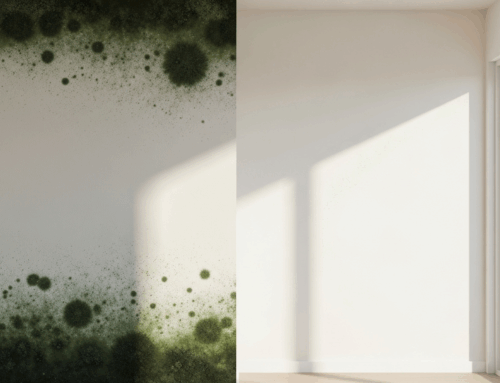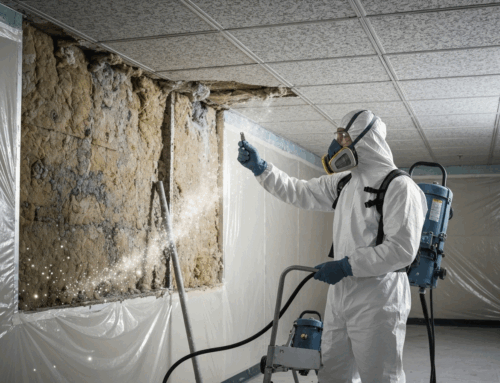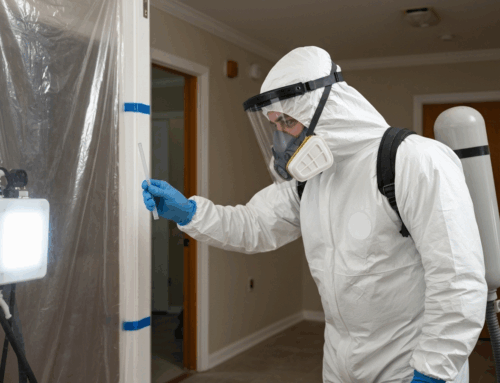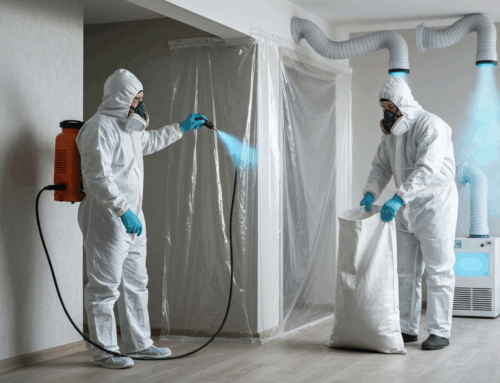Protect Your Sanctuary: Why Home Mold Prevention Matters
Your home is your haven, a place where you and your family should feel safe and healthy. However, a silent intruder—mold—can compromise both the structural integrity of your property and the well-being of its occupants. Understanding and implementing effective home mold prevention tips is crucial for maintaining a healthy living environment and protecting your most valuable investment. Mold isn’t just an unsightly nuisance; it’s a living organism that thrives on moisture and can lead to a host of problems, from persistent musty odors to significant damage to building materials and potential health concerns for sensitive individuals.
Understanding Mold: The Hidden Threat to Your Home & Health
Mold, a type of fungus, is a natural part of our environment. Its microscopic spores are ubiquitous, floating through the air both outdoors and indoors. These spores only become problematic when they land on a damp surface and find a food source, such as wood, drywall, fabric, or even dust. Once conditions are right—typically involving moisture, warmth, and organic matter—mold can begin to grow and spread rapidly, often in hidden areas like behind walls, under flooring, or in crawl spaces, making early detection challenging.
The health implications of mold exposure can vary widely among individuals. While some people may experience no symptoms, others, particularly those with allergies, asthma, or compromised immune systems, can suffer significantly. Common symptoms include:
- Nasal stuffiness, runny nose, and sneezing
- Eye irritation, redness, or watery eyes
- Skin rash or itching
- Coughing and wheezing
- Headaches and fatigue
Long-term exposure to certain molds can exacerbate existing respiratory conditions and, in rare cases, lead to more severe lung infections, according to the CDC. While “black mold” (*Stachybotrys chartarum*) often receives sensational attention, many types of mold can cause health issues, and the focus should always be on prompt removal and moisture control, not just identifying the species. The EPA and CDC agree that testing to identify mold types is usually unnecessary; the important thing is to clean it up and prevent recurrence. This reinforces the critical need for proactive home mold prevention tips.
The Fundamentals of Home Mold Prevention Tips
The core principle behind effective mold prevention is remarkably simple: moisture control. Mold cannot grow without water. Therefore, eliminating sources of dampness and reducing humidity are the most powerful strategies to keep your home mold-free. This involves a multi-faceted approach that considers all potential entry points for moisture and areas where condensation can form.
Key foundational strategies include:
- Promptly addressing water leaks: Whether from a leaky pipe, a roof issue, or a household appliance, fixing leaks immediately is paramount. Dry wet areas and materials within 24-48 hours.
- Maintaining proper indoor humidity: Aim to keep indoor humidity levels between 30% and 50%. This can be achieved through adequate ventilation, air conditioning, and dehumidifiers, especially in humid climates or damp areas like basements and crawl spaces. The EPA recommends keeping indoor humidity below 60%.
- Ensuring good ventilation: Use exhaust fans in bathrooms, kitchens, and laundry rooms to vent moisture outside. Opening windows when practical also helps.
- Regular cleaning and maintenance: Cleaning surfaces regularly can remove mold spores before they have a chance to grow. Keeping gutters clean and ensuring proper exterior drainage are also vital.
Mastering Moisture Control: Your Home’s Best Defense Against Mold
Moisture control is the cornerstone of any successful mold prevention strategy. This goes beyond just visible leaks and encompasses everything from plumbing to environmental humidity. Ignoring moisture issues is an open invitation for mold to establish itself and thrive.
Consider these proactive moisture control measures:
- Fixing Leaks Immediately: Any drip, no matter how small, can lead to significant mold growth. Regularly inspect plumbing under sinks, around toilets, and near appliances for signs of leaks. Repairing leaks within 24-48 hours is crucial.
- Drying Wet Areas Quickly: After spills, overflows, or even routine cleaning, ensure that all surfaces are thoroughly dried. Do not leave damp towels on floors or wet clothes in washing machines.
- Dehumidifiers: In humid climates, or in naturally damp areas like basements and crawl spaces, dehumidifiers are invaluable. These devices extract excess moisture from the air, helping to maintain ideal humidity levels (30-50%). Regular cleaning of dehumidifier drip pans is important to prevent mold growth within the unit itself.
- Foundation Drainage: Ensure that the ground around your home slopes away from the foundation. This directs rainwater away from your house, preventing it from pooling and seeping into your basement or crawl space. Clean and repair roof gutters and downspouts regularly to ensure proper water diversion.
- Crawl Space Encapsulation: For homes with crawl spaces, encapsulation is a highly effective long-term solution. This involves sealing the crawl space with a heavy-duty vapor barrier and often integrating a dehumidifier, creating a conditioned space that resists moisture intrusion. This is a common service offered by experts like Piedmont Quality Air for crawl space mold removal in SC.
Smart Ventilation Strategies for a Drier Indoor Environment
Proper ventilation plays a significant role in managing indoor humidity and preventing condensation, which are key elements of effective home mold prevention tips. Stagnant, humid air creates a breeding ground for mold spores, so encouraging air movement and exhausting moist air to the outside is essential.
Implement these ventilation strategies:
- Exhaust Fans: Install and regularly use exhaust fans in high-moisture areas such as bathrooms, kitchens, and laundry rooms. Ensure these fans vent air outside, not into attics or other enclosed spaces where moisture could accumulate. Run bathroom fans during and after showers for at least 30 minutes. Use kitchen range hoods when cooking to remove steam.
- Clothes Dryers: Verify that your clothes dryer is properly vented to the outside and that the vent line is clear of obstructions. A clogged or improperly vented dryer can release a significant amount of moisture into your home.
- Open Windows and Doors: When outdoor humidity levels are low, opening windows and doors for short periods can help circulate air and reduce indoor humidity, especially during cooler times of the day.
- HVAC System Maintenance: A properly functioning HVAC system not only controls temperature but also removes humidity. Ensure your system is sized correctly for your home and that ducts are free of leaks and blockages. Regular cleaning of air conditioning drip pans and ensuring drain lines flow freely are critical.
Securing Your Home’s Envelope: Addressing External Water Sources
The exterior of your home, often referred to as its “envelope,” is its first line of defense against moisture. Breaches in this barrier allow water to enter, creating hidden dampness that can lead to widespread mold growth. Addressing external water sources is a proactive and fundamental aspect of successful home mold prevention tips.
Focus on these areas:
- Roofing: Regularly inspect your roof for damaged or missing shingles, loose flashing, and blocked gutters. Promptly repair any issues to prevent water intrusion into the attic or walls.
- Siding and Exterior Walls: Check siding for cracks, gaps, or signs of water penetration. Ensure proper seals around windows and doors. Water can seep through tiny openings, causing extensive damage and mold growth within wall cavities.
- Window and Door Seals: Inspect and maintain caulking and weatherstripping around all windows and doors. These seals degrade over time, creating pathways for moisture and drafts.
- Basements and Foundations: Inspect your basement or crawl space walls for cracks or leaks. Ensure proper grading outside directs water away from your foundation. Waterproofing solutions may be necessary for persistent issues.
- Landscaping: Trim trees and shrubs away from your house to prevent moisture retention against exterior walls and to avoid debris clogging gutters. Ensure garden beds do not slope towards your foundation.
The Dangers of DIY Mold Removal & When to Call an Expert
While small patches of surface mold (less than 10 square feet) can often be managed with household cleaners and proper personal protective equipment (PPE), larger or persistent mold problems pose significant risks. Attempting extensive mold removal in Charlotte, Concord, Hickory, NC, or other areas without proper training and equipment can exacerbate the problem. Disrupting mold without containment can release millions of spores into the air, spreading contamination to other areas of your home and increasing health risks for occupants.
There are specific scenarios where professional intervention is not just recommended, but essential:
- Large Infestations: If mold covers an area greater than 10 square feet (roughly 3 feet by 3 feet), the EPA advises consulting a professional.
- Hidden Mold: If you detect a persistent musty odor but cannot see the mold, it is likely growing behind walls, under floors, or in HVAC systems. Investigating hidden mold requires specialized equipment and expertise to avoid widespread contamination.
- Health Concerns: If anyone in your household experiences persistent health issues that you suspect are related to mold exposure, or if individuals with compromised immune systems, severe allergies, or asthma are present, professional assessment and remediation are crucial.
- Contaminated Water: If the mold growth resulted from sewage, floodwaters, or other contaminated water, a professional with experience in hazardous material cleanup is required. For instance, post-flood scenarios might involve both mold and asbestos remediation, as seen in South Carolina after floods.
- Recurrent Mold: If mold keeps returning after your cleaning efforts, it indicates an unaddressed underlying moisture problem that requires expert diagnosis and repair.
Professional mold remediation companies, like Piedmont Quality Air, employ trained and certified technicians who utilize specialized equipment, containment protocols, and air filtration systems to safely and effectively remove mold and address its root cause. They ensure that the problem is not just masked but thoroughly resolved, safeguarding both your property and your health. Choosing a professional is an investment in restoring your home’s value after mold and achieving lasting peace of mind.
Piedmont Quality Air: Your Partner in a Mold-Free Home
At Piedmont Quality Air, we understand the complexities of mold and the critical importance of effective home mold prevention tips. With years of experience serving Charlotte, Concord, Hickory, NC, and surrounding areas, our team of trained and certified professionals is dedicated to providing comprehensive mold solutions. From meticulous inspections to safe and thorough remediation, we are equipped to handle mold challenges of all sizes, ensuring your home or business is a healthy and safe environment.
We pride ourselves on our systematic approach:
- Expert Identification: Our professionals utilize advanced tools like moisture meters and thermal imaging to accurately pinpoint mold growth and its underlying moisture source, even in hidden areas. For instance, a professional mold inspection in South Carolina can uncover issues invisible to the naked eye.
- Safe & Effective Removal: We adhere to strict industry standards and safety protocols, employing containment strategies and HEPA filtration to prevent spore spread during removal.
- Moisture Source Rectification: Beyond removing visible mold, our primary focus is on identifying and fixing the root cause of moisture, preventing future recurrence.
- Restoration & Prevention: We not only remove the mold but also guide you on the best long-term prevention strategies, ensuring lasting results.
Our commitment to quality service and customer satisfaction is reflected in testimonials from homeowners who have experienced the difference our expertise makes. We are your trusted local partner, dedicated to helping you achieve a mold-free living space.
A Breath of Fresh Air: Achieving Lasting Mold Prevention
Achieving lasting mold prevention is an ongoing commitment to vigilance and proactive maintenance. By consistently applying the home mold prevention tips outlined, you can significantly reduce the risk of mold growth and protect your property and health for years to come. Remember, the key is always moisture control.
Regularly perform these checks:
- Monitor indoor humidity levels, especially in basements and crawl spaces, using a hygrometer.
- Promptly address any signs of leaks or water intrusion, no matter how minor.
- Ensure proper ventilation in bathrooms, kitchens, and laundry areas.
- Keep your home clean and dry, especially after any water event.
- Inspect your home’s exterior for potential vulnerabilities to water entry.
Should you suspect a mold problem that goes beyond minor surface growth, do not hesitate to seek professional assistance. Experts like Piedmont Quality Air possess the knowledge, equipment, and experience to diagnose and resolve complex mold issues safely and effectively, ensuring your home remains a healthy sanctuary. By taking these steps, you are not just preventing mold; you are investing in the long-term health, safety, and value of your home.
Ready to protect your home from mold?
Don’t wait until mold becomes a major problem. For expert mold inspection, removal, or prevention services, contact Piedmont Quality Air today and ensure a healthier living environment for your family.






